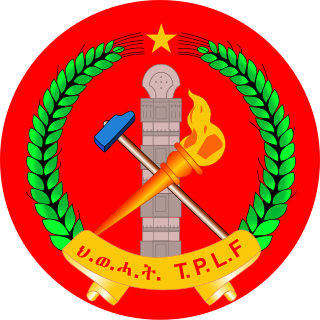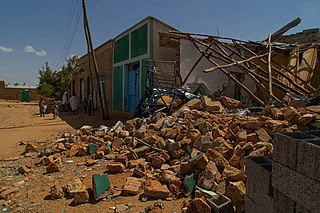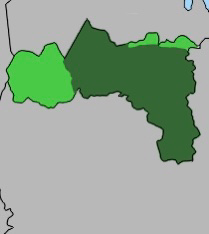| |||||
| Decades: | |||||
|---|---|---|---|---|---|
| See also: | Other events of 2023 Timeline of Eritrean history | ||||
Events in the year 2023 in Eritrea .
| |||||
| Decades: | |||||
|---|---|---|---|---|---|
| See also: | Other events of 2023 Timeline of Eritrean history | ||||
Events in the year 2023 in Eritrea .
| Photo | Post | Name |
|---|---|---|
| | President | Isaias Afewerki [1] |
| President of National Assembly |

The Tigray Region, officially the Tigray National Regional State, is the northernmost regional state in Ethiopia. The Tigray Region is the homeland of the Tigrayan, Irob, and Kunama people. Its capital and largest city is Mekelle. Tigray is the fifth-largest by area, the fifth-most populous, and the fifth-most densely populated of the 11 regional states.

Isaias Afwerki is an Eritrean politician and partisan who has been the president of Eritrea since shortly after he led the Eritrean People's Liberation Front (EPLF) to victory in 24 May 1991, ending the 30-year-old war for independence from Ethiopia.

The Tigray People's Liberation Front, also called the Tigrayan People's Liberation Front, is a leftist ethnic nationalist paramilitary group, and the former ruling party of Ethiopia. It was classified as a terrorist organization by the Ethiopian government from May 2021 until its removal from the list in March 2023. In older texts and Amharic publications, it is known as Woyane or Wayane.

Humera is a town in the Kafta Humera woreda in the Tigray Region of Ethiopia. Located in the Western Zone the town has an elevation of 585 metres (1,919 ft) above sea level. The Tekezé river borders the town to the north. Humera is a very important regional agricultural center based on intensive agriculture. It is the last Ethiopian town south of the border with Eritrea and Sudan, and is considered to be a strategically important gateway to Sudan.

The Oromo conflict is a protracted conflict between the Oromo Liberation Front (OLF) and the Ethiopian government. The Oromo Liberation Front formed to fight the Ethiopian Empire to liberate the Oromo people and establish an independent state of Oromia. The conflict began in 1973, when Oromo nationalists established the OLF and its armed wing, the Oromo Liberation Army (OLA). These groups formed in response to prejudice against the Oromo people during the Haile Selassie and Derg era, when their language banned from public administration, courts, church and schools, and the stereotype of Oromo people as a hindrance to expanding Ethiopian national identity.
Events of 2020 in Ethiopia.

The Tigray War was an armed conflict that lasted from 3 November 2020 to 3 November 2022. The war was primarily fought in the Tigray Region of Ethiopia between the Ethiopian federal government and Eritrea on one side, and the Tigray People's Liberation Front (TPLF) on the other.
This timeline of the Tigray War is part of a chronology of the military engagements of the Tigray War, a civil war that began in the Tigray Region of Ethiopia in early November 2020.

The Al-Fashaga conflict was a conflict between Sudan and Amhara militants from Ethiopia in the disputed border region of al-Fashaga. Since 2008, Ethiopia has dropped all claims to the al-Fashaga as long as Sudan allowed Ethiopian farmers and militants to stay in the area undisturbed. With the outbreak of the Tigray War, Sudanese forces were able to move into the region due to an agreement with Ethiopia just three days before. When Amhara militants left to assist the federal government in the war, Sudanese forces started to drive out Ethiopian farmers, effectively breaking the 2008 compromise. Ethiopia has also accused Sudan of killing Amhara farmers. The Government of Sudan claims the involvement of ENDF and Eritrean troops in the border dispute while the Ethiopian government denies this and regards the conflict as skirmishes between Sudanese forces and ethnic militias from the Amhara region.
The spillover of the Tigray War has had an impact on other countries in the surrounding region, particularly in Sudan. This spillover mainly consisted of Ethiopian refugees, more than 50,000 of which have crossed the Ethiopia–Sudan border. There have also been border clashes, mostly between the Sudanese Armed Forces and Ethiopian militias, but the Sudanese government has also claimed ambushes by the Ethiopian National Defense Force have taken place. Most of the fighting centered in Al-Fashaqa, a fertile plain claimed by both Sudan and Ethiopia.

All sides of the Tigray War have been repeatedly accused of committing war crimes since it began in November 2020. A September 2022 report by the UN found evidence of widespread "war crimes and crimes against humanity" committed by all parties, in particular, the Ethiopian federal government, the State of Eritrea and the Tigray People's Liberation Front (TPLF)."

The Tigray Defense Forces, colloquially called the Tigray Army is a paramilitary group located in the Tigray region of Ethiopia. It was founded by former generals of the Ethiopian Military in 2020 to combat federal forces enforcing national government mandates in the Tigray region, culminating in 2020 with the outbreak of the Tigray War. The TDF has made use of guerilla tactics and strategies. Human rights groups including Amnesty International and Human Rights Watch have reported that the TDF has committed war crimes against civilians including gang rape and extrajudicial killing during their occupation of both the Afar and Amhara regions. According to the Ethiopian Ministry of Justice, TDF combatants have been found liable for upwards of 540 civilians casualties. as of 28 December 2021.
This Timeline of the Tigray War is part of a chronology of the military engagements of the Tigray War, a civil war that began in the Tigray Region of Ethiopia in early November 2020.

Abiy Ahmed became the Prime Minister of Ethiopia on April 2, 2018. He was formerly the chairman of the Ethiopian People's Revolutionary Democratic Front (EPRDF) from 2018 until its dissolution in 2019 when it was replaced by the Prosperity Party.

The 1995 Ethiopian Federal Constitution formalizes an ethnic federalism law aimed at undermining long-standing ethnic imperial rule, reducing ethnic tensions, promoting regional autonomy, and upholding unqualified rights to self-determination and secession in a state with more than 80 different ethnic groups. But it is divisive, both among Ethiopian nationalists who believe it undermines centralized authority and fuels interethnic conflict and among ethnic federalists who fear that the development of its vague components could lead to authoritarian centralization or even the maintenance of minority ethnic hegemony. Parliamentary elections since 1995 have taken place every five years since enactment. All but one of these have resulted in government by members of the Ethiopian People's Revolutionary Democratic Front (EPRDF) political coalition, under three prime ministers. The EPRDF was under the effective control of the Tigrean People's Liberation Front (TPLF), which represents a small ethnic minority. In 2019 the EPRDF, under Abiy, was dissolved and he inaugurated the pan-ethnic Prosperity Party which won the 2021 Ethiopian Election, returning him as prime minister. But both political entities were different kinds of responses to the ongoing tension between constitutional ethnic federalism and the Ethiopian state's authority. Over the same period, and all administrations, a range of major conflicts with ethnic roots have occurred or continued, and the press and availability of information have been controlled. There has also been dramatic economic growth and liberalization, which has itself been attributed to, and used to justify authoritarian state policy.

On 24 May 1993, Eritrea gained independence from Ethiopia following a United Nations sponsored referendum, which gained 99.8% Eritrean support for independence. Isaias Afwerki became president and head of Eritrea, after fighting with his Eritrean People's Liberation Front (EPLF) against the authoritarian Derg government during the Ethiopian Civil War from 1974 to 1991. Eritrea became a one-party state and promised to schedule presidential elections in 2001, but was then delayed indefinitely without precondition. Isaias became a totalitarian leader and was accused by many watchdogs of repression and purges of journalists, dissent and opposition groups like People's Front for Democracy and Justice (PFDJ) officials, mass surveillance, arbitrary detention, lack of independent judiciary body and freedom of association, press, and speech. In 2015, the United Nations Commission of Inquiry on Eritrea reported that there were "systemic, widespread and gross human rights violations carried out in a context of total lack of rule of law". The Freedom in the World ranked Eritrea "not free" state as of 2022, with a total 3/100 score in both political rights and civil liberties.
Events in the year 2022 in Eritrea.
On 2 November 2022, a peace treaty was signed between the government of Ethiopia and the Tigray People's Liberation Front (TPLF), where both parties agreed to a "permanent cessation of hostilities" to end the Tigray War. The agreement was made effective the next day on 3 November, marking the two-year anniversary of the war.
Between October 14 and 18, 2022, Ethiopian troops aided by Eritrean forces launched an offensive into Shire, in the separatist Tigray region. While Shire had been at the forefront of the conflict since 2020, the October 2022 offensive towards the town solidified Ethiopian and Eritrean control over it, and was the last major battle before peace negotiations began that November.

The Eritrea–Sudan border is 686 km (426 mi) in length and runs from Eritrea and Sudan's tripoint with Ethiopia in the south, to the town of Ras Kasar in the very south of Eritrea. The border has been the sight of several tensions, with deportations, border conflicts and colonialism by the United Kingdom and Italy. The border has also seen illegal acts such as human trafficking and hundreds of illegal crossings made by Eritreans. Due to the Tigray War, Sudan saw a surge of Eritrean and Ethiopian civilians cross it's border with Eritrea and by 2023 there were nearly 130,000 refugees and civilians confirmed living in the country.